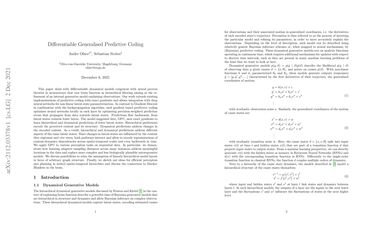Differentiable Generalised Predictive Coding
This paper deals with differentiable dynamical models congruent with neural process theories that cast brain function as the hierarchical refinement of an internal generative model explaining observations. Our work extends existing implementations of gradient-based predictive coding with automatic differentiation and allows to integrate deep neural networks for non-linear state parameterization. Gradient-based predictive coding optimises inferred states and weights locally in for each layer by optimising precision-weighted prediction errors that propagate from stimuli towards latent states. Predictions flow backwards, from latent states towards lower layers. The model suggested here optimises hierarchical and dynamical predictions of latent states. Hierarchical predictions encode expected content and hierarchical structure. Dynamical predictions capture changes in the encoded content along with higher order derivatives. Hierarchical and dynamical predictions interact and address different aspects of the same latent states. We apply the model to various perception and planning tasks on sequential data and show their mutual dependence. In particular, we demonstrate how learning sampling distances in parallel address meaningful locations data sampled at discrete time steps. We discuss possibilities to relax the assumption of linear hierarchies in favor of more flexible graph structure with emergent properties. We compare the granular structure of the model with canonical microcircuits describing predictive coding in biological networks and review the connection to Markov Blankets as a tool to characterize modularity. A final section sketches out ideas for efficient perception and planning in nested spatio-temporal hierarchies.
PDF Abstract